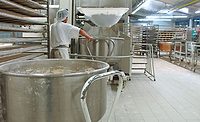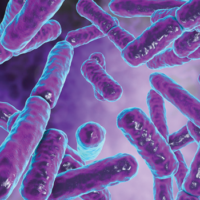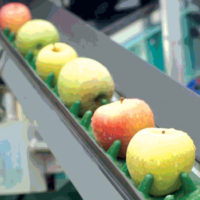What exactly is a biofilm and how does it adhere to food processing equipment? Why is it important to establish corrective actions that will eradicate them and prevent them from reoccurring? How can you prevent positive finished product microbial results and reduce the amount of product that needs to be put on hold for further testing and disposition? These are some of the questions that many sanitarians and production managers ask whenever there is an indication that the sanitation program is not effective in preventing product contamination.
Biofilms are bacterial films consisting of a mixture of different microorganisms, along with product residues and polysaccharides excreted by the microorganisms that help them to attach to surfaces. You can say that these films become a living community with a life of its own and the means to exist and perpetuate if allowed to do so. Wherever there are the right conditions for biofilms, they will form and establish themselves. Biofilms in food production environments are an indication that sanitation programs are inadequate and can become the potential root cause for reduction of shelf life and pathogenic contamination of food products.
Conditions of Food Processing Equipment
Biofilms can establish themselves on almost any surface in the food production environment. Some solid surfaces that can harbor microorganisms include stainless steel, aluminum, rubber, Teflon® and other nylon materials, which exist in almost every food production plant. It is absolutely critical that surfaces are properly maintained. Surfaces that are scratched, pitted, corroded or cracked are difficult to clean and therefore provide the environment needed for biofilms to establish themselves.
When food processing equipment can’t be easily cleaned due to its design and food particles are not removed, these food particles assist in the formation of biofilms by providing a layer that not only provides the biofilm with nutrients but with a surface to which it can easily adhere.
Environmental conditions in food production areas also play a role in biofilm formation. Food production environments provide all the elements that microorganisms need in which to grow: food, acidity, temperature, moisture, oxygen and time. A plant sanitation program must be designed and implemented to ensure the creation of a hygienic environment that supports the production of food products where food safety and quality are not compromised. Sanitary preventive maintenance, equipment monitoring and timely repairs are essential to assist in the ability to perform adequate sanitation. Equipment maintenance is important after removing biofilms because biofilms can also deteriorate surfaces, making them more vulnerable to corrosion.
Biofilm Formation Steps
All microorganisms need a source of nutrients. Food particles, especially proteins, provide the conditions for the first step of biofilm formation to take place. Organic and inorganic particles from the production process that sit on equipment for prolonged periods will act as the base to which microorganisms can attach. Microorganisms can come from almost everywhere, including soil, raw ingredients, water, air, etc. If they are present in the production environment, they can easily adhere to food sources on production equipment surfaces. Long production schedules provide the times necessary for the microorganisms to multiply and become firmly attached. Extended schedules can also cut into the necessary sanitation time needed to eliminate and prevent biofilms from becoming established. During the formation of the conditioning layer, the attraction forces of food particles and microorganisms are somewhat weak, and prompt intervention from sanitation can be essential for their removal. Depending on the type of microorganism, bacteria in a biofilm use motility appendages (e.g., fimbriae, flagella, pili) and polysaccharide substances that they can secrete through their membranes to assist in the process of attaching themselves to surfaces.
The conditioning layer formed by nutrients and substances secreted by the microorganisms involved provides the environment where even injured cells can repair and multiply. Those bacteria in the film continue to secrete a polysaccharide substance that acts as cement, making the attachment to the surface very difficult to remove, and protects the bacteria in the colony against cleaners and sanitizers. Biofilms may contain pathogens such as Listeria monocytogenes, Staphylococcus aureus and Salmonella among others.
Determining whether biofilms are present on equipment surfaces can be achieved through different methods. The most inexpensive approach is the use of one’s senses. During visual inspection, biofilms may be detected by a rainbow-like appearance on stainless steel. Touch can be used as well; a good indication that a biofilm is occurring is if there is a slimy feel over what looks like an otherwise clean surface. Adenosine triphosphate (ATP) bioluminescence devices that can be used to detect the presence of organic materials may not detect the presence of mature films.[1] However, ATP technology can still be used during the elimination of biofilms to give an indication of the progress being made. Bio-films can also be detected through microbial sampling of the equipment, and sporadic spikes in environmental sampling reports can be tracked. Such spikes, although sporadic, require immediate attention and corrective actions to prevent them from reoccurring. Microbial swab samples can be taken to verify sanitation effectiveness through testing for indicator organisms like aerobic plate count and coliforms. Positive coliform testing results could be used as an indication that the sanitation process is inadequate. Microbial testing can also be used to validate high ATP results.
The Role of Sanitation
Whether you are dealing with a dairy, bakery or a meat packing plant, a good sanitation program plays a key role in preventing biofilms from establishing permanently on processing equipment.
All sanitation programs must have a balanced combination of physical and chemical methods to assist in the cleaning process. Physical cleaning methods may involve manual scrubbing, clean out of place (COP) and clean in place (CIP). Chemical methods involve knowing what types of soils are present in the production environment, selecting the right cleaning chemicals in order to effectively remove food particles and choosing the right sanitizers accordingly. Chemical application is also affected by what type of physical cleaning will be applied. No matter what cleaning procedure will be used, there are four main factors that should be taken into consideration, and they work just like Critical Control Points in a Hazard Analysis and Critical Control Points (HACCP) plan. Those factors are time, temperature, concentration and mechanical action.
Remember that long production schedules allow more time for microorganisms to multiply and establish themselves on equipment surfaces. Good operational sanitation practices help to control microorganisms until wet cleaning cycles are performed. Adequate time should be provided to perform wet cleaning thoroughly and, when chemicals are applied, adequate contact time with equipment surfaces should always be allowed so they can effectively work on soils. All product labels should be read thoroughly and manufacturer’s recommendations followed.
Water temperatures should typically be 140–160 °F, but no less than 120 °F and no more than 160 °F. Some chemical compounds work well with warm water, while some work well at ambient temperature. Water at a temperature of 180 °F (the temperature permitted by the U.S. Department of Agriculture and U.S. Food and Drug Administration in lieu of a chemical sanitizer) actually aids in the formation of biofilms.[2] Keep in mind that hot water can denature proteins, create baked-on soils on surfaces, cause the precipitation of minerals and make removal of biofilms more difficult.
More is not always better when it comes to sanitation chemicals. When it comes to the concentration of chemicals, it is helpful to understand the chemistry and how it assists in removing the soils. Depending on the soils, alkaline or acid cleaners can be used. It is suggested that an alkaline cleaner, preferably a chlorinated alkaline, be used for daily cleaning and at least once a week on stainless steel equipment. An acid cleaner can be used following the alkaline cleaner to eliminate any mineral scale on the equipment. Active chlorinated cleaning chemicals are very effective in breaking chemical bonds, allowing for the formation of more soluble particles and facilitating the sanitation process. Again, the chemical manufacturer’s label should be read.
A surface needs to be clean in order for sanitizers to be effective. By cleaning, food particles, minerals along with organic and inorganic soils are removed from surfaces. By sanitizing, the amounts of microorganisms still present on the surfaces are further reduced.
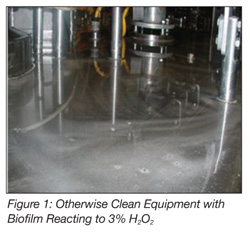 Most chemical suppliers have product description sheets that provide information about chemical effectiveness against specific microorganisms. Knowing the types of microorganisms that are living in the biofilms helps in the selection of the right chemicals for treatment. Chlorine, iodophors and most quaternary ammonium compounds are ineffective against removing them.[2] On the other hand, peroxide and peroxiacetic sanitizers have been found to be more effective in the removal of biofilms (Figure 1).
Most chemical suppliers have product description sheets that provide information about chemical effectiveness against specific microorganisms. Knowing the types of microorganisms that are living in the biofilms helps in the selection of the right chemicals for treatment. Chlorine, iodophors and most quaternary ammonium compounds are ineffective against removing them.[2] On the other hand, peroxide and peroxiacetic sanitizers have been found to be more effective in the removal of biofilms (Figure 1).
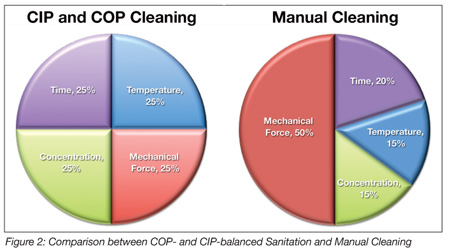 Mechanical action can be obtained in several ways, depending on the cleaning process for the specific type of equipment. COP and CIP cleaning methods use solution flow under pressure as the mechanical action to remove soils on the equipment being cleaned. The need for manual scrubbing is less necessary with these two cleaning processes, but it should be noted that when using the CIP method to clean equipment, some manual scrubbing may also be necessary (Figure 2). Some items like pumps, gaskets, clamps and other components that are not cleaned by the turbulent solution flow may require additional cleaning. To break the strong bonds of a biofilm, manual cleaning is an absolute neccessity. The act of brushing, scrubbing or scraping helps in releasing any bacterial cells from the surface and makes them less resistant to the action of chemicals.
Mechanical action can be obtained in several ways, depending on the cleaning process for the specific type of equipment. COP and CIP cleaning methods use solution flow under pressure as the mechanical action to remove soils on the equipment being cleaned. The need for manual scrubbing is less necessary with these two cleaning processes, but it should be noted that when using the CIP method to clean equipment, some manual scrubbing may also be necessary (Figure 2). Some items like pumps, gaskets, clamps and other components that are not cleaned by the turbulent solution flow may require additional cleaning. To break the strong bonds of a biofilm, manual cleaning is an absolute neccessity. The act of brushing, scrubbing or scraping helps in releasing any bacterial cells from the surface and makes them less resistant to the action of chemicals.
As biofilms mature, segments of the microbial colony can become dislodged from the original colony where they can be transported to other sections of the production equipment. When this occurs, the cycle starts all over again. Those cells can become attached to new locations on the equipment surface, where they can regenerate, multiply and form yet another biofilm. Not only that, the biofilm could also be transferred to finished product, causing spoilage and potential food safety issues. The best tool in removal of biofilms is prevention.
In summary, a plant’s sanitation program needs to be created and followed based on four critical factors: time, temperature, concentration and mechanical action. If there is a need to reduce the level of one of these factors, compensation for the reduction must occur by raising the level of one or more of the others. Failure to adequately clean equipment can result in biofilms that may require special cleaning methods to effect removal. When it comes to sanitation, short cuts are never a good idea. The result may be increased product being put on hold, more product waste, potential recalls and unnecessary food safety risks. Avoiding these problems helps to mitigate risk and improves a company’s bottom line.
Gloryann Mejias-Sarceno has worked in food manufacturing for 14 years. She has experience with HACCP systems, HIMP-pork slaughter, food safety programs, sanitation, quality systems and food plant production. She is currently a sanitation/set-up manager at Wells Enterprises, Inc.
References
1. Cramer, M. M. 2006. Food plant sanitation. Boca Raton, FL: CRC Press Taylor & Francis Group.
2. Deibel, V. 2003. Biofilms. Internet Journal of Food Safety 1:6–7.
Inadequate Sanitation Results in Biofilm Formation


